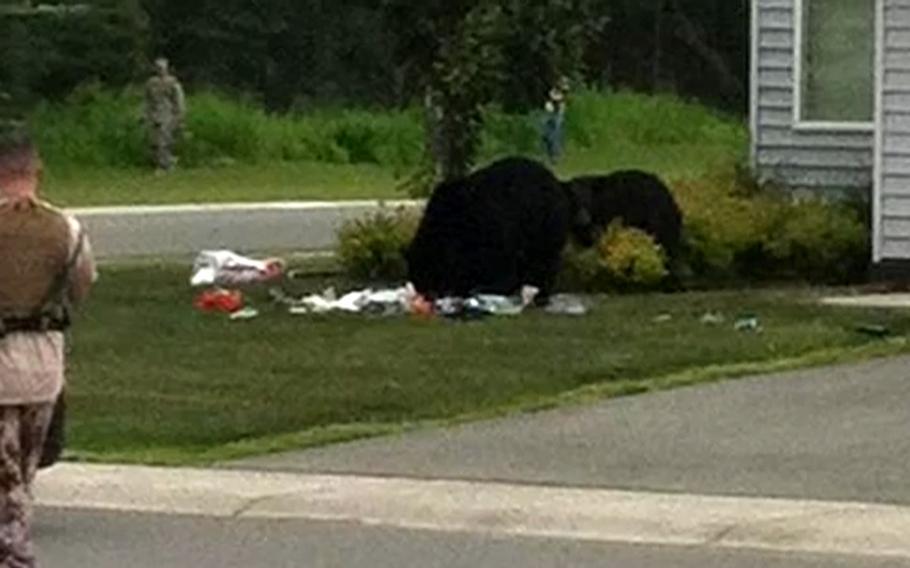
Bears rummage through items left out in a housing area of Joint Base Elmendorf-Richardson in Alaska in 2014. (U.S. Air Force )
Bear sightings at Alaska’s largest military installation are nearing a battalion-sized count for 2024.
About 600 reports of black and grizzly bears in and around Joint Base Elmendorf-Richardson near Anchorage this year have been filed with the Wildlife Conservation Law Enforcement Office.
“This is Alaska, and bears are very common,” said Erin Eaton, the base chief public affairs officer. “The majority of these calls require little to no intervention and are just bears passing through the area.”
The more than 30,000 soldiers, airmen and civilians at the base have learned to share the natural space surrounding the nearly 65,000-acre base with moose, elk, and other wildlife of central Alaska.
But the interlopers who get the most attention at Elmendorf-Richardson are the bears. The base is the headquarters of several commands, including the 11th Air Force and the Army’s 11th Airborne Division.
Bears have been photographed rummaging through soldiers’ curbside belongings, diving into dumpster trash and clawing at discarded home furnishings in the base’s suburban-like neighborhoods.
On Oct. 28, the base’s Wildlife Conservation Law Enforcement Office received reports of bears getting into a food storage area. By the time the officers arrived, the feasters had moved on, leaving just the cardboard and wrapper carnage of emptied field rations called MREs, or Meals Ready to Eat.

Personnel with the Joint Base Elmendorf-Richardson Wildlife Conservation Law Enforcement Office responded to a report on Oct. 28, 2024, of a bear entering a building used to store equipment and supplies, including MREs. Personnel observed some boxes containing cold-weather meals and individual MRE packages had been opened. (Joint Base Elmendorf-Richardson Wildlife Conservation Law Enforcement Office)
Base officials couldn’t ascertain which of the approximately two dozen MRE combinations the bears gorged on. Among MRE offerings listed on an Army website are Jalapeno Pepper Jack Beef Patty, Chicken Chunks, Spinach Mushrooms & Cream Sauce Fettuccine, Lemon Pepper Tuna and Maple Sausage.
Fittingly for Halloween, the most recognizable element in the photos supplied by the Army of the bear feast were empty bags of M&M chocolate candy.
Less than a week later, Eaton said, a report came in “a little after midnight” of bears sighted inside a motor pool building. The wildlife agents arrived to find what they say was a 1-year-old bear behind the driver’s wheel of a Humvee.

Joint Base Elmendorf-Richardson Wildlife Conservation Law Enforcement personnel responded to a report on Nov. 2, 2024, of a bear being inside a motor pool building. Upon entering the building, officers observed a black bear in one of the military vehicles. (Joint Base Elmendorf-Richardson Wildlife Conservation Law Enforcement Office)
Army personnel took photos of the intruder, then opened exterior doors and distracted the bear, allowing it to amble off undisturbed away from the compound.
The base encourages a “live and let live” approach to the bears, with specially trained wildlife officers responding to reports of sightings around populated areas.
“We strongly encouraged to report all bear sitings near parks, schools, housing and dumpsters,” Eaton said.
Colette Brandt, the Elmendorf-Richardson wildlife biologist with the 673rd Civil Engineer Squadron, briefs newcomers on how to keep wildlife away as a bear-related best practices for base residents.
Wildlife safety messages are also put up each spring when bears emerge from their dens. Residents are also reminded to remove outdoor bird feeders before bears begin actively seeking food.
Summer’s exceptionally long warm days — with sometimes about 20 hours of sunshine — are a favorite for humans to go hiking and bears to go strolling. If paths cross, a wide berth for the furry travelers is suggested.
James Wendland, the Elmendorf-Richardson wildlife conservation law enforcement officer with the 673d Civil Engineer Squadron, said bear interactions at the end of autumn are common as their usual sources of nourishment diminish with the onset of the prolonged Alaskan winter.
“When more natural food for bears like berries, crabapples and salmon become scarce, bears will seek other sources,” he said. “Bears are opportunistic and will follow their noses looking for food, even if that’s in open buildings or unlocked vehicles.”
Recommendations to Elmendorf-Richardson residents include limiting the Halloween display of pumpkins or jack-o-lanterns, as they attract moose.
Winter comes early at the base, which is 2,200 miles north of Seattle.
The 1,200 service members who enjoyed an early Thanksgiving feast at the base commissary on Nov. 26 reported no bears sniffing around for festive foods.
It helped that the thermometer showed temperatures in the teens and below on a day when the sun was up for less than seven hours.
“It’s turned sharply colder lately,” Eaton said. “Since the end of October, the bear reports at Joint Base Elmendorf-Richardson have steadily declined to zero.”
By Christmas Eve, the sun rises at 10:15 a.m. and sets just before 3:15 p.m. Temperatures overnight plunge below zero.
The grizzly and black bears that live in the forests around the base are likely snug in their dens, well into their long winter hibernation.
Eaton said everyone knows it’s a relatively short break, and bears will return with the longer days of spring.
“They’ll be back,” she said.